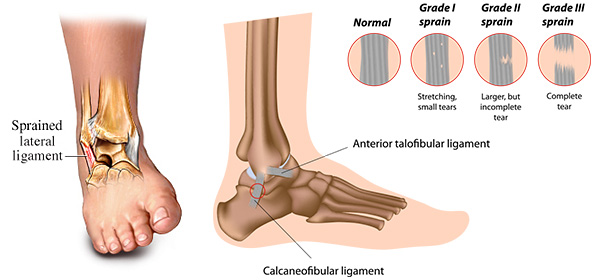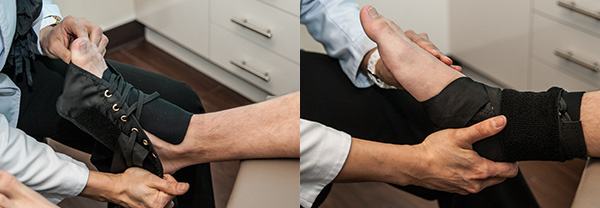Ankle sprain occurs when ligaments in the ankle joint are either stretched or torn. Ligaments are like tough, strong bands but when they’re overstressed, they can tear.

Ankle sprains frequently occur among runners. It is one of the most common sports-related injuries.
Depending on the amount of ligament tearing, a sprain can be mild, moderate, or severe. The accumulation of fluids after a ligament injury may cause symptoms characteristic of a sprained ankle: swelling, pain, and bruising of the ankle and foot. Some individuals will experience frequent ankle sprains due to previous ankle injury or congenital ligament laxity. Certain foot type and lower extremity alignment are prone to ankle sprains.

Inversion ankle sprains caused by inward turn of the foot are most common.
Most ankle sprains occur when the foot is suddenly turned inward, tearing the outside ligaments. Sprains of the ligament group on the inside of the ankle are less common because it is less likely for the foot to be forced outward and because inside ligaments are stronger.
Mild Sprain
A mild sprain occurs when there is minimal force with only slight stretching or tearing of the ligament group. Swelling and pain are minor; walking is generally possible.
Moderate Sprain
A moderate sprain occurs when a ligament group is partially torn. Swelling, pain, and bruising are greater; walking may be difficult.
Severe Sprain
In a severe sprain, a ligament group can be completely torn; swelling and pain are immediate and obvious. Bruising can appear on both sides of the ankle and boney injury may also occur at the same time. Typically the person is unable to weight bear due to pain.

Ankle sprain can cause partial or complete tear of supporting ligaments.
Diagnosis and Evaluation
The doctor will examine your ankle and order x-rays if necessary to determine the nature and extent of your ankle injury. For chronic injuries, the ankle ligaments will be tested for rupture or laxity. The overall alignment of your lower extremities will also be evaluated.
Conservative Treatment and Rehabilitation
Your treatment will depend on clinical and radiographic evaluation. They may consist of:
- Elevation of the injured ankle to the level of your heart and ice pack around the area to reduce swelling and pain.
- Immobilization of the ankle in an ankle brace, walker boot, or cast may be necessary to ensure proper healing of torn ligaments. When soft tissue such as ligaments are injured, they may take anywhere from 3 to 6 months to heal.


An ankle brace can be helpful in reducing swelling and pain right after an ankle sprain. It can also be used to prevent future injuries.
- Physiotherapy exercises such as range of motion, stretches, strength training, and proprioceptive training.
- Custom Orthotics if malalignment of the foot or leg is found to be cause of frequent ankle sprains.
Surgical Treatment
Occasionally ligaments are severely torn or chronically loose from frequent sprains. In this case, surgery is indicated to repair the injured ligament.
The most common cause of persistent pain following an ankle sprain is due to incomplete rehabilitation. This means that patients either don’t complete the right type of rehabilitation or they don’t progress properly (i.e. too fast or too slow). If you feel that your progress is not going along properly, ensure you seek advice from a doctor who specializes in the foot and ankle.
If you suffer pain after an ankle injury or experience frequent ankle sprains, our doctor who has extensive knowledge in treating this problem can help. Contact us for an appointment today.

